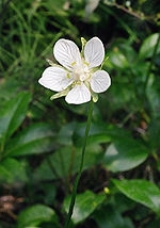
Parnassia palustris
Encyclopedia
Parnassia palustris, commonly called Marsh Grass-of-Parnassus, Northern Grass-of-Parnassus, and Bog-star, is a species
of the genus
Parnassia
.
It is the county flower of Cumbria
and Sutherland
in the United Kingdom
, and appears on the county arms of the former county. The name comes from ancient Greece: evidently the cattle on Mount Parnassus appreciated the plant; hence it was an "honorary grass".
Species
In biology, a species is one of the basic units of biological classification and a taxonomic rank. A species is often defined as a group of organisms capable of interbreeding and producing fertile offspring. While in many cases this definition is adequate, more precise or differing measures are...
of the genus
Genus
In biology, a genus is a low-level taxonomic rank used in the biological classification of living and fossil organisms, which is an example of definition by genus and differentia...
Parnassia
Grass of Parnassus
The genus Parnassia, also known as Grass of Parnassus or bog-stars, are plants in the family Celastraceae. The plants occur in arctic and alpine habitats, as well as in dune systems and fens, swamps, moist woods, and across the Northern Hemisphere. It is actually not a grass, but an herbaceous dicot...
.
It is the county flower of Cumbria
Cumbria
Cumbria , is a non-metropolitan county in North West England. The county and Cumbria County Council, its local authority, came into existence in 1974 after the passage of the Local Government Act 1972. Cumbria's largest settlement and county town is Carlisle. It consists of six districts, and in...
and Sutherland
Sutherland
Sutherland is a registration county, lieutenancy area and historic administrative county of Scotland. It is now within the Highland local government area. In Gaelic the area is referred to according to its traditional areas: Dùthaich 'IcAoidh , Asainte , and Cataibh...
in the United Kingdom
United Kingdom
The United Kingdom of Great Britain and Northern IrelandIn the United Kingdom and Dependencies, other languages have been officially recognised as legitimate autochthonous languages under the European Charter for Regional or Minority Languages...
, and appears on the county arms of the former county. The name comes from ancient Greece: evidently the cattle on Mount Parnassus appreciated the plant; hence it was an "honorary grass".
External links
- Marsh Grass-of-Parnassus, Talk about Wildlife

